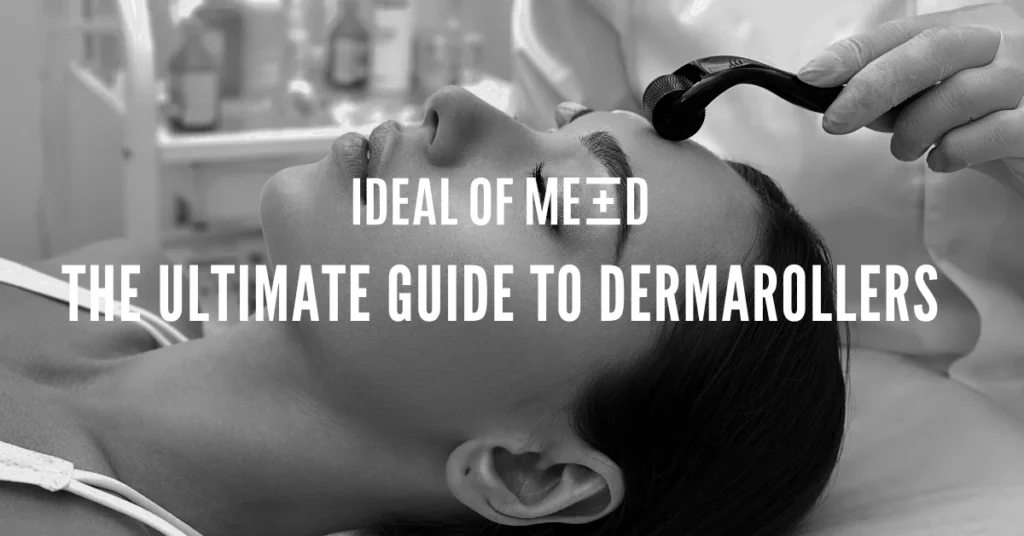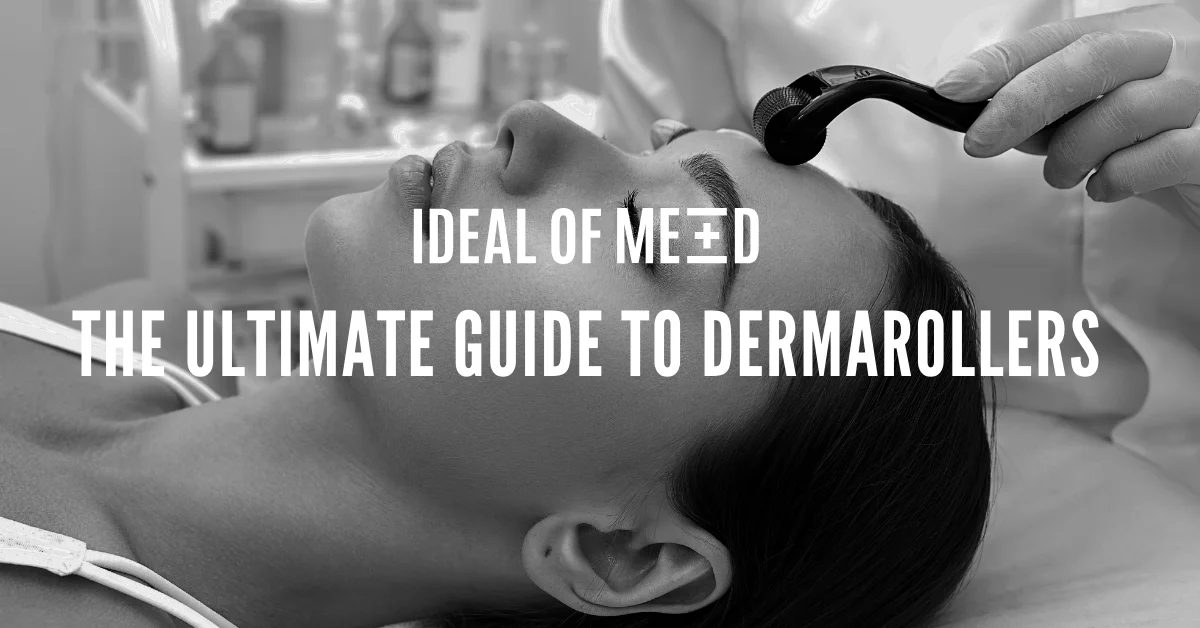There is tons of information on the internet about dermarollers, but not all of it is true. And for the most part, people often try to sell you a product without giving you the pros and cons.
As a beauty expert, I’ve done the hard work for you. This is the ultimate guide on dermarollers. I’ll answer all your questions and give you a truly independent, in-depth overview of derma rollers.
Let’s get rolling!

Is a dermaroller right for me?
Dermarollers are an effective way to boost the skin and scalp and can improve several health concerns, including hair rejuvenation and several skin conditions. Dermarollers can be used for:
- Hair rejuvenation
- Acne scars
- Enlarged pores
- Hyperpigmentation
- Uneven skin tone or texture
- Wrinkles and ageing
- Cellulite and stretch marks
- Severe scars from burns or surgery or deep stretch marks
Of course, the type of condition you are aiming to treat requires an individual approach. I’ve put together a few guidelines for the microneedle length and excellent products to use depending on the condition you wish to treat; that’s super easy to use.
Select the condition you are treating, and there’s information about the needle size, how often you should use your dermaroller, and what products you can use with your dermaroller.
| Condition | Microneedle size | Frequency of treatment | Products to use before |
|---|---|---|---|
| Acne scars | 0.75–1.0 mm (shallow) or 1.5 mm (deeper) | Every 4–6 weeks (0.75–1.0 mm), or every 6–8 weeks (1.5 mm) | Collagen‑boosting serum (hyaluronic acid, stem cells, peptides) |
| Enlarged pores | 0.25–0.5 mm | Weekly | Niacinamide, hyaluronic acid, EGF, tranexamic acid, copper peptides |
| Hyperpigmentation | 0.5–1 mm | Weekly | Retinol and vitamin C serums |
| Uneven skin tone/texture | 0.5 mm | Weekly | Retinol and vitamin C serums |
| Ageing & wrinkles | 0.5 or 1.0 mm | Weekly or biweekly | Anti‑ageing serum (hyaluronic acid, niacinamide) |
| Hair rejuvenation | 0.5–1.5 mm (0.5 mm at home, longer professionally) | 0.5 mm: weekly/monthly; 0.75‑1.0 mm: monthly | Ideal of MeD serum, Minoxidil |
| Cellulite & stretch marks | 1.5–2.0 mm | Every 6–8 weeks | Collagen‑boosting serum (hyaluronic acid) |
| Severe scars/burns | 2.5–3.0 mm | Every 8 weeks | Peptides, hyaluronic acid, vitamin C serums |
Should I go to a professional or use a dermaroller myself?
This is a common question people ask. Obviously, at-home treatment will be far more affordable and convenient than booking an appointment with a professional. But there are definitely benefits to choosing a professional. If you have a dermaroller treatment with a professional, they often use longer needles and use a pen; this can be more effective and may require fewer sessions to achieve the results you want.
If you want to treat more serious conditions such as severe scarring or burns, you will need to use longer needles, and a professional treatment will be better for you. A professional can also administer a local anaesthetic, and you may see results after just one session.
A professional treatment can also be helpful for you to learn how to use a derma roller safely and effectively and how it should feel with the correct amount of pressure applied. You can then go on to use a derma roller at home, knowing what you are doing and avoiding common mistakes.
What does it feel like? Does it hurt? Will I bleed?
Dermaroller needles vary in size, starting from 0.2 mm to over 3 mm. The smallest needles are usually painless with no bleeding. Larger needles (over 1.5 mm) may cause mild pain and bleeding. Using numbing cream is advisable for longer needles—15–20 minutes before for facial use, 20–30 minutes before for body, and 30–40 minutes before for scalp.
On the scalp, expect tingling and a pricking sensation—redness and tenderness are common afterwards, but your hair will cover it.
What serum should I use with a dermaroller?
After microneedling, your skin is much more absorbent—up to 15–20× more receptive. Match your products based on the condition:
For acne: wait 8 hours before benzoyl peroxide or salicylic acid; glycolic acid requires a 2-day wait post-treatment.
What can I use in conjunction with a dermaroller to treat hair loss?
A common and effective combo is dermarolling with minoxidil, as microneedling boosts absorption. Use your roller only once per week alongside your regular minoxidil routine.
For post-hair transplant care, consider Ideal of MeD rejuvenating shampoo and conditioner to support growth—these include ingredients like ProPacil, biotin, saw palmetto, aloe vera, panthenol, keratin, and collagen.
Dermarolling: What results to expect?
Results vary. Redness, swelling, and slight bleeding may occur; peeling can start 3–5 days later. Moisturise and avoid picking—improved skin tone/texture often appears within a week, with gradual results over time.
For hair growth: expect visible improvements around 8–10 weeks of weekly use. After a transplant, start dermarolling ~3 months post‑surgery. Full transplant results typically emerge 6–9 months afterward.
Is a dermaroller an effective post-hair transplant treatment?
Yes. Studies show microneedling + minoxidil produces much better results than minoxidil alone—82% saw ≥50% improvement versus 4.5% with minoxidil alone . Always wait ~3 months post-transplant, start professionally, then continue at home.
I’m scared of needles—can I still use a dermaroller?
Dermaroller needles are tiny and don’t feel like injections. Most users tolerate them well; if needed, apply numbing cream or choose professional treatments for comfort.
Who should avoid dermarollers?
Avoid using on sunburn, inflamed skin, eczema, psoriasis, blood clotting disorders, acne, warts, or if using retinol (stop 5 days prior). For active pimples, consider a derma stamp instead.
How should I treat my dermaroller after each use?
Clean after each use by soaking in soapy water, then disinfect in 70% isopropyl alcohol for 10 minutes. Store dry in its case.
Common dermaroller mistakes
- Using too often: Allow full skin recovery—follow table timing based on needle length.
- Pressing too hard: Moderate pressure only—minor bleeding is okay; excessive bleeding is harmful.
- Low-quality tools: Choose titanium or stainless steel; avoid cheap rollers with uneven/bent needles.
- No sunscreen: Apply SPF 30+ the day after.
- Not replacing roller: Replace after 10–15 uses, or when needles dull or bend.
- Wrong needle size: Match needle to condition—too small is ineffective, too large causes damage.
- Makeup too soon: Wait at least 8 hours post‑roll before applying makeup.
Conclusion
Dermarollers are a powerful tool for improving skin conditions and stimulating hair growth. Follow this guide to use them safely and effectively.
Got any questions we haven’t covered? Book a free consultation—we’re here to help.




